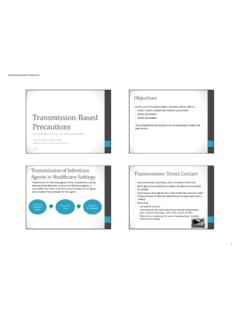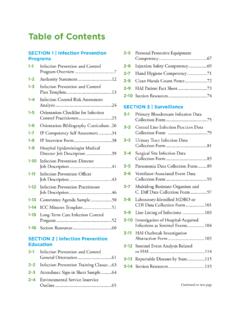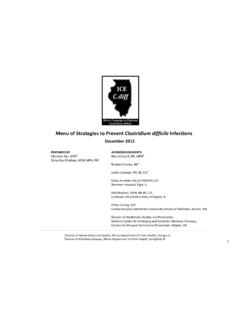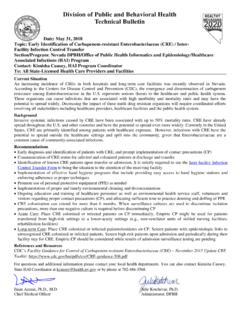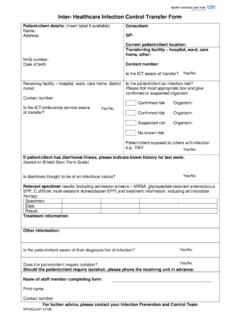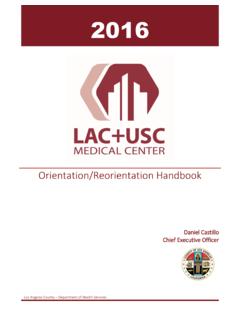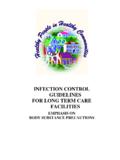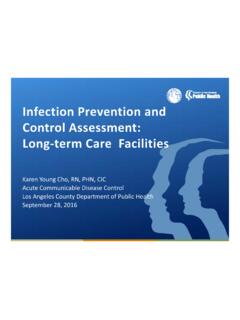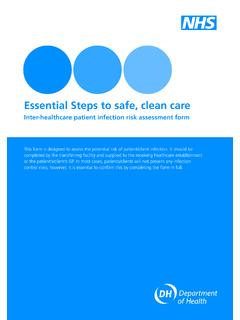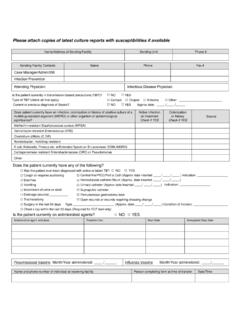Transcription of When Sharing ISN’T Caring: Preventing HAI / MDRO …
1 When Sharing ISN T Caring: Preventing HAI / MDRO Transmission Infection Prevention: A Community Effort Symposium September 9, 2011 Jennie Finks, DVM, MVPHUnit Manager and Antimicrobial Resistance EpidemiologistSurveillance for Healthcare-Associated & Resistant Pathogens (SHARP) UnitSurveillance & Infectious Disease Epidemiology (SIDE) SectionMichigan Department of Community HealthOutline Definitions and organisms Prevention & control strategies MDCH SHARP HAI & MDRO surveillance and prevention activities Questions and answersTransmission Locations: More than just Hospitals! Acute care hospitals Long term care Long term acute care Ambulatory surgical centers Home care Wound care clinics Dialysis facilities Outpatient facilities and offices Schools and daycares Gyms and pools Correctional facilitiesThe list goes on and are Healthcare-Associated infections (HAIs)?
2 infections acquired within a healthcare facility hospital, long term care facility, & other Not present on admission Not incubating at time of admission to facility Previously called nosocomial infections What are Multidrug-Resistant Organisms (MDROs)? Organisms with decreased susceptibility to multiple classes of antimicrobial agents Most often bacteria Commonly are healthcare-associated infections (HAIs) Increasing prevalence in communityThe OrganismsAlphabet soup!!! MRSA (CA-MRSA and HA-MRSA) VRE VISA VRSA MDR GNB: ESBLs, KPCs, and CREsAnd lets not Clostridium difficile Influenza Rotavirus Rhinovirus Norovirus TB HBV / HCV and HIV / AIDS Et for TransmissionSusceptible HostSourceMode or RouteRisk Factors for HAI / MDRO Acquisition Existing severe illness Underlying disease or condition Invasive medical procedures Repeated contact with healthcare system Prolonged hospitalization Previous colonization with a MDRO Elderly and immune-compromisedRoutes of Transmission Contact Person to person, direct or indirect Most MDROs Droplet Respiratory droplets (>5 m) to host mucosa over short distance ( 3 feet) Airborne Small particles ( 5 m)
3 Infective over time and distance Bloodborne Poor injection technique most frequent exposureInfection control Precautions Standard Transmission-based = ISOLATION Contact Droplet AirborneStandard Precautions All blood, body fluids, secretions (except sweat), nonintact skin, and mucus membranes assumed infectious Apply to all patients, regardless of suspected or confirmed infection status, in any setting in which healthcare is delivered Application determined by Nature of interaction Extent of anticipated blood, body fluid, or pathogen exposure Have an ESSENTIAL role in Preventing transmission in ALL healthcare settingsStandard Precaution Measures Hand hygiene Respiratory hygiene / cough etiquette Safe injection practices Use of personal protective equipment (PPE)
4 PPE = gloves, gown, mask, eye protection, and/or face shield Handling of contaminated equipment / environment Wear gloves for direct contact Contain heavily soiled equipment Properly clean and disinfect or sterilize reusable equipmentContact Precautions For infections spread by contact and patients with excessive wound drainage, fecal incontinence, or other bodily discharges Herpes simplex virus (HSV), respiratory syncytial virus (RSV), Staphylococcus aureus, most MDROs Gown and gloves for every interaction with the patient or potentially contaminated environmentDroplet Precautions For pathogens spread through close respiratory or mucous membrane contact with respiratory secretions Bordetella pertussis, influenza virus, adenovirus, rhinovirus, Mycoplasma pneumoniae, SARS- associated coronavirus (SARS-CoV), group A streptococcus, and Neisseria meningitidis Personnel don mask for patient contact Single patient rooms or separation of 3 feet with curtain Mask patient (if tolerated)
5 When transporting outside room and adhere to respiratory hygiene / cough etiquetteAirborne Isolation For agents that remain infectious over long distances when suspended in the air Mycobacterium tuberculosis, rubeola virus (measles), and varicella-zoster virus (chickenpox) Airborne infection isolation room (AIIR) Alternative: private room with door closed, patient mask, and N95 for personnel Providers wear mask or respiratorPatient Placement Single-patient rooms Airborne Precautions Preferred for Contact and Droplet Precautions Cohort patients By HAI / MDRO With patients at low-risk for acquisition and adverse outcomes, and short staysInter-facility Infection control Transfer Form Available under Long Term Care Toolkits at: Infection control Transfer Form (continued) Released April 2011 Summary guide of infection prevention recommendations for outpatient (ambulatory care) settings Available at.
6 Pdfs/guidelines/Ambula Stewardship Promote adherence to appropriate prescribing guidelines among providers Decrease demand for antibiotics for viral upper respiratory infections among healthy adults and parents of young children Increase adherence to prescribed antibiotics for upper respiratory infections Reporting Requirements Influenza Weekly aggregate reports Novel strain cases Pediatric deaths HBV, HCV, HIV / AIDS, TB Methicillin resistant Staphylococcus aureus (MRSA) outbreaks Vancomycin-intermediate and -resistant Staphylococcus aureus (VISA/VRSA) Invasive Streptococcus pneumoniae, susceptible and drug- resistant Unusual occurrence, outbreak or epidemic of any disease or condition Includes healthcare-associated infections (HAIs) Includes epidemiologically significant organisms Carbapenemase-resistant Enterobacteraciae (CRE) Includes noro, rota, rhino and influenzaNew Surveillance Initiative Formation of SHARP Unit in 2009 Surveillance of healthcare-associated infections and MDROs through voluntary participation of Michigan hospitals Data collected from National Healthcare Safety Network (NHSN) Currently, 50 participating hospitals Sharing data with SHARP UnitPrevention Collaboratives GOAL.
7 To implement evidence-based infection control measures for purpose of reducing infection rates in hospitals. Partnering with existing collaboratives MHA Keystone: HAI, Catheter- Associated Urinary Tract Infection (CAUTI) Initiative MPRO: MDRO/MRSA InitiativeNEW! Prevention Collaboratives MRSA/CDI in acute, long term care, and long term acute care facilities CRE in acute, long term care, and long term acute care facilities (grant application pending) Future: SSI in acute and ambulatory surgical centers?MDCH HAI Website Content: Annual and Quarterly Reports Sample facility report Frequent updates RESOURCES For IPs For publicMDCH SHARP Unit (517) 335-8165 Finks, DVM, MVPH SHARP Unit Manager Judy Weber, MPH Healthcare Facility Liaison Jennifer Beggs, MPH Infectious Disease and Preparedness Epidemiologist Gibson, MPH National Healthcare Safety Network (NHSN) Epidemiologist Gail Denkins, RN MRSA / CDI Prevention Initiative Coordinator Coyle, MPH Infection control Consultant JD, Rhinehart E, Jackson M, Chiarello L, and the Healthcare Infection control Practices Advisory Committee, 2007 Guideline for Isolation Precautions.
8 Preventing Transmission of Infectious Agents in Healthcare JD, Rhinehart E, Jackson M, et al. The Healthcare Infection control Practices Advisory Committee (HICPAC). Management of Multidrug-Resistant Organisms in Healthcare Settings, 2006. PW, Bennett G, Bradley S, Drinka P, Lautenbach E, Marx J, Mody L, Nicolle L, Stevenson K; SHEA/APIC Guideline: Infection Prevention and control in the Long- Term Care Facility. Infect control Hosp Epidemiol 2008;29:785 814










